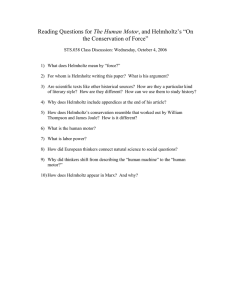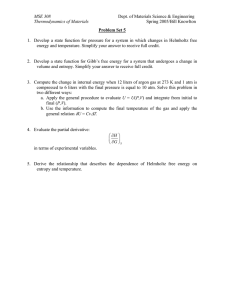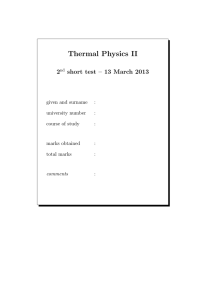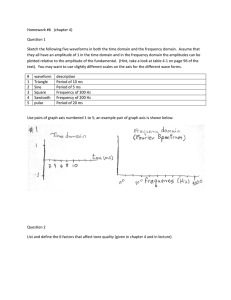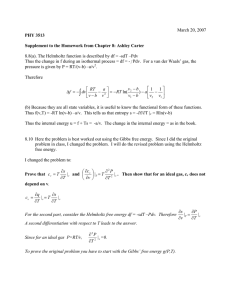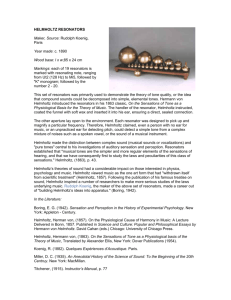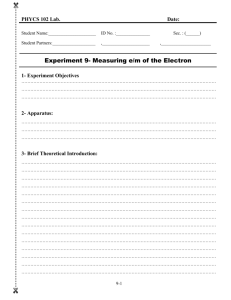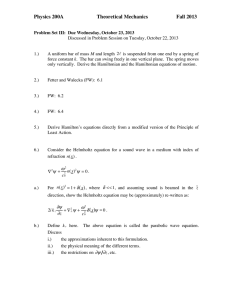Helmholtz`s `psychological` time experiments
advertisement
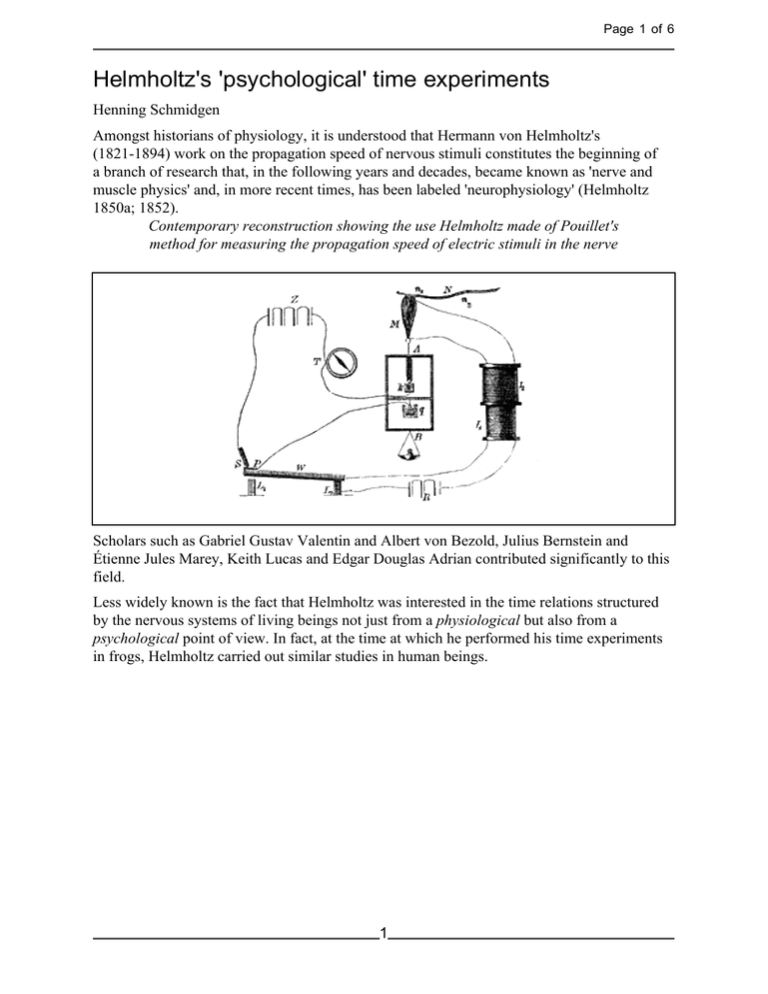
Page 1 of 6 Helmholtz's 'psychological' time experiments Henning Schmidgen Amongst historians of physiology, it is understood that Hermann von Helmholtz's (1821-1894) work on the propagation speed of nervous stimuli constitutes the beginning of a branch of research that, in the following years and decades, became known as 'nerve and muscle physics' and, in more recent times, has been labeled 'neurophysiology' (Helmholtz 1850a; 1852). Contemporary reconstruction showing the use Helmholtz made of Pouillet's method for measuring the propagation speed of electric stimuli in the nerve Scholars such as Gabriel Gustav Valentin and Albert von Bezold, Julius Bernstein and Étienne Jules Marey, Keith Lucas and Edgar Douglas Adrian contributed significantly to this field. Less widely known is the fact that Helmholtz was interested in the time relations structured by the nervous systems of living beings not just from a physiological but also from a psychological point of view. In fact, at the time at which he performed his time experiments in frogs, Helmholtz carried out similar studies in human beings. 1 Page 2 of 6 In comparison with his frog experiments, Helmholtz's work on humans presented special challenges. For obvious reasons, the experiments could not be conducted on preservable preparations separated from the rest of the organism. Helmholtz tried to circumvent this difficulty by measuring what today's psychologists would call 'simple reaction times'. Helmholtz described the basic structure of his experiments: In a human being, a very weak electric shock is applied to a limited space of skin. When he feels the shock, he is asked to carry out a specific movement with the hand or the teeth interrupting the time measurement as soon as possible. (Helmholtz, 1883 [1850], p. 878) When all parameters remained constant, Helmholtz had found in the results of these experiments a 'surprising constancy'. As he reported to the Berlin Physical Society on December 15, 1850, the results of repeated experiments in different subjects oscillated between a mean of 0.12 and 0.20 seconds. Within each series, however, there was only a 'probable error' of 0.003 seconds (Helmholtz, 1850a, p. 2) The relative homogeneity of measurements seemed to be a good precondition for deducing the duration of single aspects of the reaction process from the 'sums' of reaction times Helmholtz obtained. In other words, the Königsberg physiologist could start systematically to change single parameters of the experimental set up, holding the other parameters constant or at least assuming that they remained constant. 2 Page 3 of 6 Before Helmholtz started these experiments, he had hypothesized distinct aspects or phases of the reaction process he observed. This was facilitated by the telegraphic metaphor Helmholtz used as did many of his contemporaries. Needle Telegraph produced by Matthäus Hipp in the late 1860s Thus, he explained that one part of the time between stimulation and reaction was consumed by the 'sending of the signal' (i.e. the stimulus) through the sensory nerves. Another portion of time (which Helmholtz assumed to be exactly as small or large as the first) was needed to transmit the 'message' through the motor nerve to the muscle. The remaining bit, Helmholtz concluded was the time required 'in the brain for the processes of perceiving and willing' (Helmholtz, 1883 [1850], p. 878). 3 Page 4 of 6 The concrete procedure Helmholtz then used was to stimulate the human body in different places (e.g. in the foot and the neck) and to derive the speed of the propagation of the stimulus within the sensory nerves from the differences in the results obtained. Helmholtz assumed that, as to their duration, the brain processes of perceiving and willing do not depend essentially from the position of the skin part that was hit. In this perspective, it seemed to be plausible that the stimulation of different skin regions of the human body only altered 'the first link' of the reaction chain (i.e. the propagation in the sensory nerves) (ibid.). Helmholtz, 1850a, p. 3 (Detail with Transcription) The results Helmholtz obtained showed that the propagation of stimulations in the human sensory nerves were approximately twice as fast as those in the frog. As he explained in his communication to the Physical Society, the difference between the time needed to react to a stimulation of the big toe and the time needed to react to a stimulation of the sacrum suggested a stimulation speed of 62.1 meters per second. Comparing the reactions to finger stimulations with those to stimulations of the neck gave a result of 61.0 meters per second (Helmholtz, 1850a, p. 3). Helmholtz concluded that in humans, the 'message of an impression' propagates itself 'to the brain with a speed of circa 60 Meter (180 feet) [per second] and does not differ noticeably at various times' (Helmholtz 1883 [1850], p. 878). 4 Page 5 of 6 Helmholtz had to admit, however, that his experiments with humans involved a factor apt to threaten the required constancy of all others, namely the attention of the subject under experimentation. 'Slight feelings of sickness' and 'fatigue' of the experimental subject could significantly disturb the precision measurements, as well as distractions of all kinds: 'If at the time of perceiving the signal the thoughts are occupied with something else, and if the mind has to recall to itself what kind of movement one must carry out, it [the reaction] takes much more time.' (Helmholtz, 1850a, p. 4) At this point, Helmholtz had definitely reached psychological ground, and some sixty years later, attention had become a major topic in experimental psychology and was tested. Apparatus for testing attention (ca. 1910) 5 Page 6 of 6 Acknowledgements: This Essay is based on a paper "Of frogs and men: the origins of psychophysiological time experiments". Endeavour, 26, 4 (2002), pp. 142-148. See http:// www.trends.com Bibliography Primary Literature Helmholtz, Hermann von. 1850[a]. Vorläufiger Bericht über die Fortpflanzungsgeschwindigkeit der Nerventhätigkeit. Archive of the Berlin Brandenburgische Akademie der Wissenschaften (NL Helmholtz 541, 2 pages). Helmholtz, Hermann von. 1850[b]. Über die Fortpflanzungsgeschwindigkeit der Nervenreizung. Archiv für Anatomie, Physiologie und wissenschaftliche Medicin: 71-73 Helmholtz, Hermann von. 1850[c]. Note sur la vitesse de propagation de l'agent nerveux dans les nerfs rachidiens. Comptes rendus hebdomadaires des séances de l'Académie des science. 30: 204-208 Helmholtz, Hermann von. 1850[d]. Mittheilung für die physikalische Gesellschaft in Berlin betreffend Versuche über die Fortpflanzungsgeschwindigkeit der Reizung in den sensiblen Nerven des Menschen. Archive of the Berlin-Brandenburgische Akademie der Wissenschaften (NL Helmholtz 540, 4 pages). Helmholtz, Hermann von. 1850[e]. Messungen über den zeitlichen Verlauf der Zuckung animalischer Muskeln und die Fortpflanzungsgeschwindigkeit der Reizung in den Nerven. Archiv für Anatomie, Physiologie und wissenschaftliche Medicin 17: 176-364 Helmholtz, Hermann von. n. d. Deuxième Note sur la vitesse de propagation de l' agent nerveux: Par M. H. Helmholtz à Königsberg [Letter to Arago]. Archive of the Berlin Brandenburgische Akademie der Wissenschaften (NL Helmholtz 526, 6 pages). Helmholtz, Hermann von. 1851. Deuxième Note sur la vitesse de propagation de l'agent nerveux. Comptes rendus hebdomadaires des séances de l'Académie des Sciences 33: 262-265, 285 Helmholtz, Hermann von. 1852. Messungen über Fortpflanzungsgeschwindigkeit der Reizung in den Nerven. Archiv für Anatomie, Physiologie und wissenschaftliche Medicin 19: 199-216. Helmholtz, Hermann von. 1883 [1850]. Ueber die Methoden, kleinste Zeittheile zu messen, und ihre Anwendung für physiologische Zwecke. In: Helmholtz, Wissenschaftliche Abhandlungen (Vol. 2): 862-880. Leipzig: J. A. Barth Secondary Literature Brain, Robert M. and M. Norton Wise 1994. Muscles and Engines: Indicator Diagrams and Helmholtz's Graphical Methods. In: Universalgenie Helmholtz: Rückblick nach 100 Jahren, edited by Lorenz Krüger. Berlin: Akademie-Verlag: 124-145 Klauß, Klaus 1994. Die erste Mittheilung von H. Helmholtz an die Physikalische Gesellschaft Über die Fortpflanzungsgeschwindigkeit der Reizung in den sensiblen Nerven des Menschen. NTM (N.S.) 2: 89-96 Otis, Laura 2001. Networking: Communicating with Bodies and Machines in the Nineteenth Century. Ann Arbor, MI: University of Michigan Press 6
